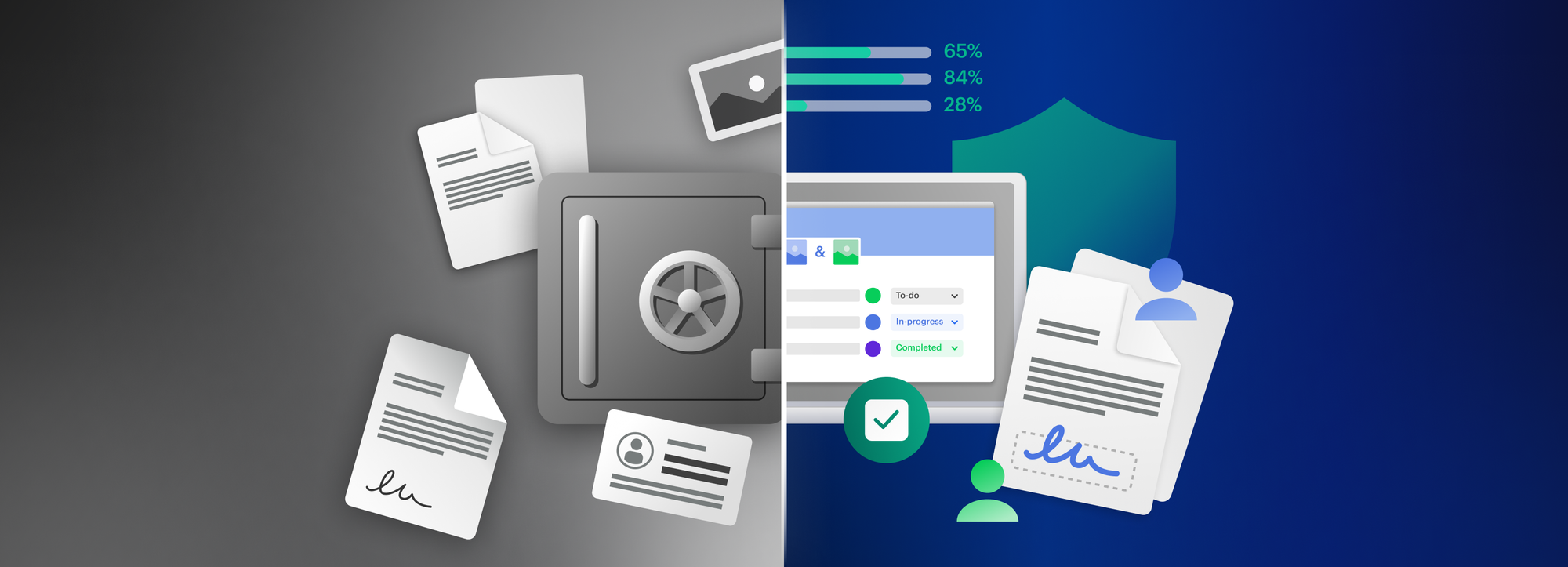What is a qualified electronic signature (QES)? Meaning, benefits, and use cases

In an increasingly tech-savvy world, businesses are redefining the very core of transactions – the signature. The paradigm shift towards electronic signatures, however, is not merely a convenience. The rise of remote work, global transactions, and the need for secure and efficient document processing have turned electronic signatures into a near-necessity.
Electronic signatures have become a commodity when it comes to streamlining processes and reducing paperwork. However, ensuring compliance and legality are still a main barrier to adoption. Qualified electronic signatures (QES) as defined by the Regulation No 910/2014 on electronic identification and trust services for electronic transactions in the internal market and repealing Directive 1999/93/EC (eIDAS) are the most secure form of eSignatures — the gold standard for ensuring legal effect and compliance. Considered to be equivalent to handwritten signatures, they hold the highest level of legal weight within Europe.
This week, we’re dissecting the concept of qualified electronic signatures, , including what they are, how they work, and all the ways they can supercharge your document management workflows.
Our upcoming State of the Union webinar focused on QES and explore how you can upgrade your document workflows with EU qualified electronic signatures.
Watch the recording now below.
SES vs. AES vs. QES: the different types of electronic signatures, explained
In the European Union, the eIDAS sets forth the requirements of electronic signatures. The European signature framework has been established to further digitalization and facilitate cross-border transactions within the region. It helps businesses transact safer, faster and more efficiently upon mutually accepted signature schemes. It also defines legality criteria for electronic signatures, meaning that businesses who rely on electronic signatures issued by trust services complying with the highest standards of eIDAS have a legally safe position in court proceedings.
As defined under eIDAS based on security and verification requirements, electronic signatures fall into three categories: simple, advanced, and qualified electronic signatures (SES, AES, and QES, respectively). Let’s see how these differ in terms of security features, authentication processes, and legal standings.
1. Simple electronic signatures (SES) are the most basic form of e-signatures. They can be anything from scanned images of a person’s ink signature through a typed name at the end of an email to any electronic process that signifies an approval. SES is widely used for its ease and convenience in less critical scenarios where the risks and legal implications are minimal.
2. Advanced electronic signatures (AES), a step up from SES, include unique identification features that are exclusively linked to the signatory. Advanced electronic signatures are not only capable of identifying the signatory but can also detect any subsequent changes to the signed document.
AES requires a higher level of security and assurance about the signatory’s identity than SES. For example, it involves digital certificates that are cryptographically linked to the signatory. However, it still lacks some of the stringent security and verification measures required for the most critical documents. As such, the evidential value of documents signed with AES is not harmonized across all EU member states. In other words, their probative value can be questioned in proceedings when certain formal requirements as defined by national laws are not met.
3. Qualified Electronic Signatures (QES) are the most secure and legally-binding form of electronic signatures, perceived to be equivalent to handwritten signatures. They provide the highest level of assurance among e-signatures, ensuring both the integrity and the non-repudiation of the signed document, along with minimal environmental impact and enhanced operational efficiency.
A qualified electronic signature requires face-to-face verification of the signatory’s identity or equivalent electronic identification means. It also necessitates the use of a secure signature creation device (SSCD) and a certificate issued by a qualified trust service provider (QTSP). Given the robust security measures involved, qualified electronic signatures are recognized with the same legal status as handwritten signatures across the EU, making them suitable for high-stake transactions and documents.
Fast, safe, legally-binding key QES benefits you don’t want to miss out on
Legality and compliance
QES, under eIDAS, provides a legal framework that ensures signed documents have the same legal standing as their handwritten counterparts. This legal acknowledgement extends across borders within the EU, facilitating seamless international transactions and cooperation.
Security and authentication
Qualified electronic signatures rely on robust encryption techniques and unique identification features, eliminating the risks of forgery and unauthorized access. This level of security is paramount in healthcare, finance, or any sector where the integrity and confidentiality of documents are non-negotiable.
Efficiency & sustainability
Qualified electronic signatures eliminate the need for physical document handling, significantly reducing the time for document processing and exchange. This not only speeds up operations but also lowers operational costs associated with printing, storage, and delivery of paper documents.
QES can also help organizations contribute to reducing paper consumption and waste, aligning with broader environmental sustainability goals, by adopting fully digital document workflows and signing processes.
How to obtain a certified digital signature in 4 steps
Obtaining a qualified electronic signature involves a series of steps to ensure the highest level of security and legal compliance:
- The first step is to select a qualified trust service provider (QTSP) that is recognized within the European Union. The list of QTSPs is publicly available among the EU Trusted Lists.
- Once a qualified trust service provider is selected, the individual or organization must undergo identity verification. This process can vary depending on the provider, but generally, it involves presenting a government-issued ID and may require a face-to-face meeting or a video call. The purpose is to thoroughly verify the signatory’s identity to tie them securely to their digital signature. For entities or organizations, additional documentation may be required to confirm the authority of the individual requesting the qualified electronic signature on behalf of the organization.
- After successful identity verification, the signatory must acquire a secure signature creation device (SSCD). SSCDs are hardware or software designed to generate and store digital signatures securely. The QTSP often provides guidance on selecting the right SSCD, ensuring it meets eIDAS regulations for security.
- The final step is the issuance of a digital certificate by the QTSP. This certificate links the signatory’s identity with their digital signature, using cryptographic methods for security. The digital certificate is stored on the SSCD, and with it, the signary can now create QESs that are legally binding and recognized across the EU.
Throughout this process, the qualified trust service provider ensures compliance with eIDAS standards, providing qualified electronic signatures that offer the highest level of security and legal recognition for electronic signatures in the European Union.
While getting a qualified electronic signature demands more effort and rigor compared to simpler forms of electronic signatures, it offers unparalleled assurances for the integrity and authenticity of digital transactions, especially for agreements where legality and security are paramount.
What are the most common uses of QES? 6 uses cases from banking to healthcare
Qualified electronic signatures are relevant in a multitude of scenarios, including:
- Contract signing and management
- Government transactions
- Healthcare records
- Banking and finance
- Cross-border transactions
- Intellectual property protection
Businesses frequently use QES for the execution of contracts, agreements, and other legally binding documents. This applies to sectors ranging from real estate, where property sales contracts are sealed, to IT, for software licensing agreements.
Many government services require secure and authenticated documents. Among other things, qualified electronic signatures are used for submitting tax returns, applying for permits, and other official paperwork, ensuring the integrity and non-repudiation of these transactions.
QESs are vital for the confidentiality and accuracy of patient records, treatment consents, and the exchange of medical data between institutions. Not to mention improved efficiency, considering that in the US, more than one-third of total expenditures for doctor visits, hospitals, long-term care, and health insurance is eaten away by bureaucracy.
For online banking transactions, loan agreements, and insurance policies, qualified electronic signatures provide the necessary level of security and authenticity to protect both the financial institution and the customer. A good example is BankID, Sweden’s digital signature validation scheme that’s used some 200 times per second.
Due to its pan-European recognition under the eIDAS regulation, QES facilitates international business dealings and operations, allowing companies to securely transact across member states without the need for physical document exchanges.
Intangible assets often make up over half of a company’s value, and up to 85% for businesses in tech and innovation heavy sectors. Applying qualified electronic signatures in the submission of patents, trademarks, and copyrights ensures the legitimacy and security of these assets.
Sign your documents with confidence: eSign by Tresorit
Tresorit’s electronic signature for documents was designed with the same vision we had for all our solutions: to give users more control over their data. Securing a digital economy means protecting all data assets the businesses manage, including documents that require a signature.
Use Tresorit eSign to:
- Electronically sign any document, whether it’s an asset purchase agreement, employment contract, or non-disclosure agreement, faster without sacrificing security
- Simplify everyday signing by using electronic signatures in a few clicks directly from Tresorit.
- Mitigate risks when handling critical documents with EU qualified eSignatures, the legal equivalent to handwritten signatures.
- Take care of the signing process in three easy steps: create an eSign request, share the request link with your collaborators, and get notified once they’re done.
- Benefit from zero-knowledge, end-to-end encryption, the gold standard for privacy, throughout the entire document management lifecycle without leaving Tresorit.
Learn more about Tresorit eSign in our State of the Union webinar, with Zsofia Molnar, Product Manager at Tresorit, who discussed Tresorit’s latest releases and had a closer look at how electronic signatures integrate seamlessly with Tresorit.
In particular, you can learn:
- All about how to upgrade your document workflows with not only electronic signatures, but also EU qualified electronic signatures.
- The benefits of elevating your document signing experience within one end-to-end encrypted platform without needing multiple tools.
- How you can set data residency options at company and user level to facilitate collaboration across boarders while maintaining strict adherence to diverse data protection laws.
Watch the recording now below.
Disclaimer:
The content of this document is for information and educational purposes only, and shall not be considered as legal advice. In the case of any specific legal questions, you should consult an attorney registered in the relevant jurisdiction where you seek advice. Laws and regulations may change from time to time, and the content of this document may not be current or accurate. To the maximum extent permittedby law Tresorit disclaims and makes no representation or warranty of any kind with respect to this material, express, implied or statutory, including representations, guarantees or warranties of merchantability, fitness for a particular purpose, or accuracy.






